I recently bought a copy of Mrs Basil Holmes’ 1896 book The London Burial Grounds. Isabella Holmes was a remarkable woman who took it upon herself to explore what had happened to the many burial grounds in inner London that had been closed in the 1850s. Her book records her findings, something which you can imagine will be a really useful resource for me when researching London’s old and forgotten burial grounds. However, what I wasn’t expecting was that the book itself would tell more stories than simply the ones contained within its pages.

The edition I bought was a first edition from 1896, with a worn spine and a few scuffs on the cover, but otherwise in pretty good nick for a book that’s over a century old. A note inside the front cover reads “J.W. Hales, December 25th, 1896” – someone received this book, when it was brand new, as a Christmas gift. Whoever J.W. Hales was, I suspect we would have something in common if they were the type of person who received a book about old burial grounds for Christmas!
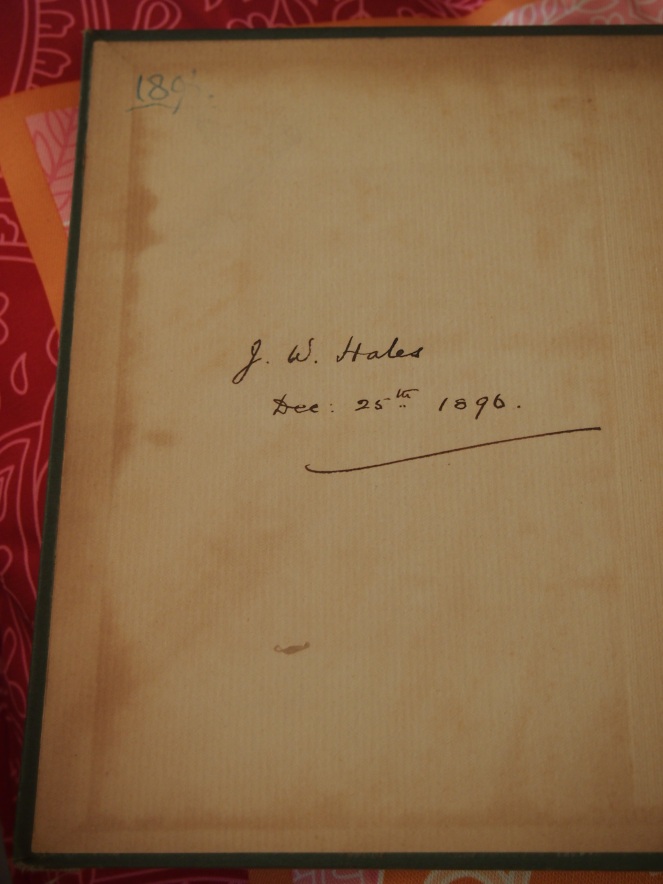
On the facing page is an “Ex libris” note. I’ve come across these in second-hand books before – many academic texts that I’ve picked up second-hand have been ex libris copies from university libraries. But this book had spent some of its life in a library that doesn’t exist at all any more – the library at the church of St Alban, Wood Street, in the City of London.
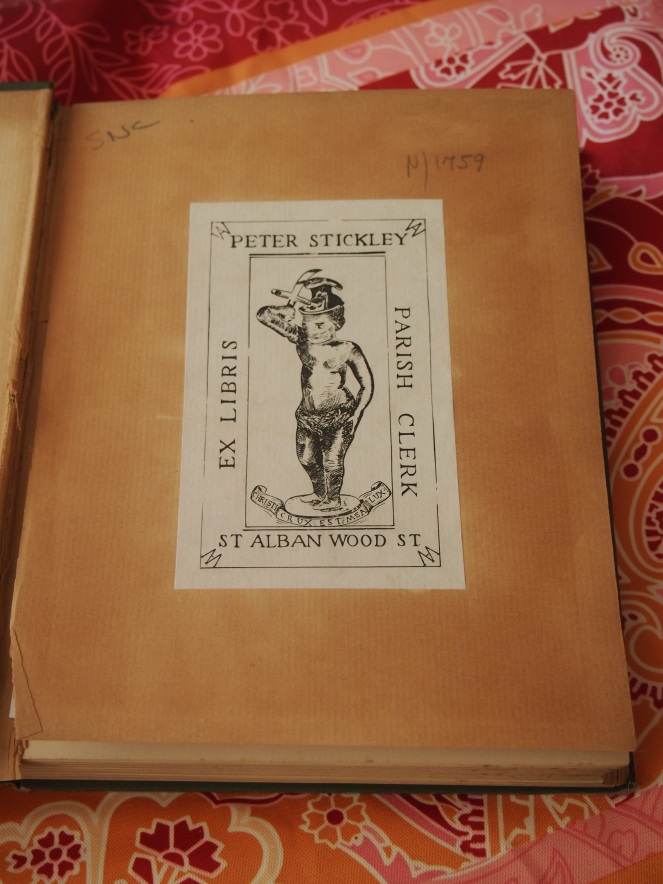
The church of St Alban, Wood Street, is believed to have its origins in the Saxon period. Offa, King of Mercia, a powerful ruler who dominated most of what is now the Midlands and south of England in the 8th Century, is said to have built a palace on the site, which included a chapel. Offa also founded St Alban’s Abbey in the city that now bears the name of that saint, Britain’s first Christian martyr who was killed in the 3rd Century. St Alban, Wood Street, was a possession of St Alban’s Abbey until the 11th Century. The church is said to have been partly built with Roman stones – probably stones robbed out of the nearby city walls or other ruined buildings in the area. This practice was very common in areas where Roman remains were situated.
In his 1598 Survey of London, John Stow describes a number of memorials that could be found in the old church. These included memorials to two 15th Century Mayors, Thomas Chatworth and John Woodcocke; a Baron of the Exchequer, Sir Richard Illingworth; and a number of members of the Worshipful Company of Mercers, whose Hall was in nearby Ironmonger Lane. John Cheke, the former schoolmaster of King Edward VI, was also buried at St Alban’s – according to John Strype, he was “broke with grief” when he died in 1557.
The medieval church was in a very poor state of repair by the early 17th Century (Strype describes it as being “wonderfully decayed and perished”), and the church was rebuilt to a design by Inigo Jones in 1634. This church, like so many others, was destroyed in the Great Fire of 1666 and rebuilt by Sir Christopher Wren in the Gothic style, apparently influenced by the previous church on the site. The nearby church of St Olave, Silver Street, was not rebuilt after the Great Fire and its parish was merged with that of St Alban, as was that of St Michael, Wood Street, after its demolition in 1897.
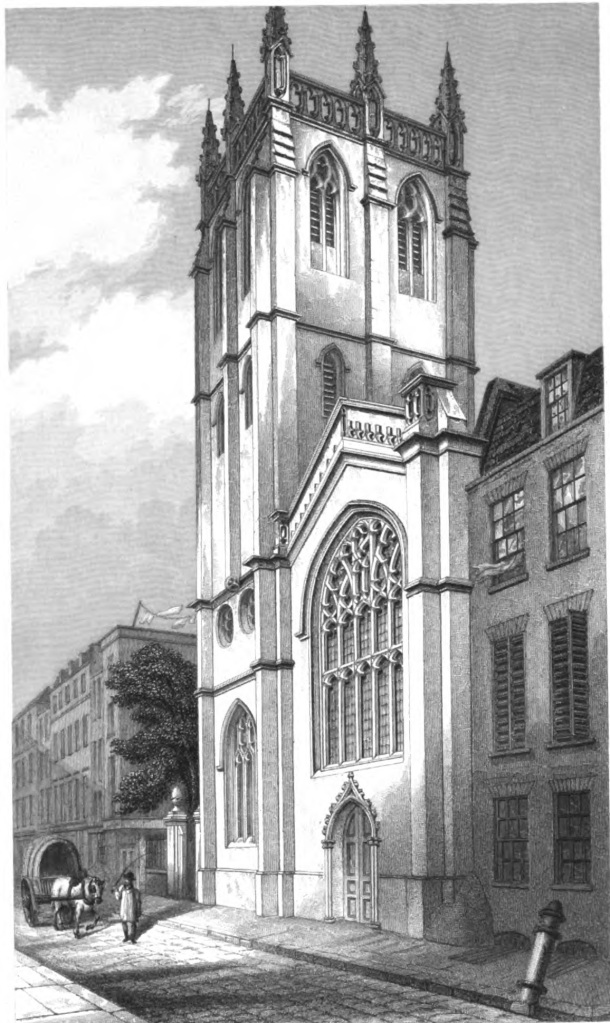
Opposite the pulpit in the rebuilt church was an hourglass, “by which the preacher could measure his sermon and test his listeners’ patience.”
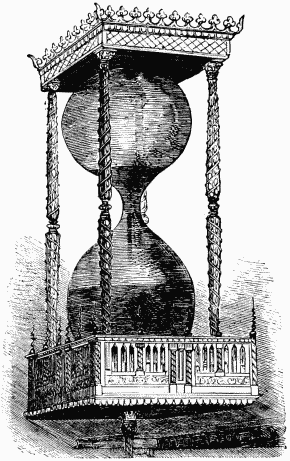
The church tower was completed in 1685, and the building was restored by the eminent Gothic Revival architect George Gilbert Scott in the 1850s, who added the semicircular apse seen in the image below. The pinnacles on the tower were added in the late 19th Century. And so it might still appear today, were it not for the Blitz.
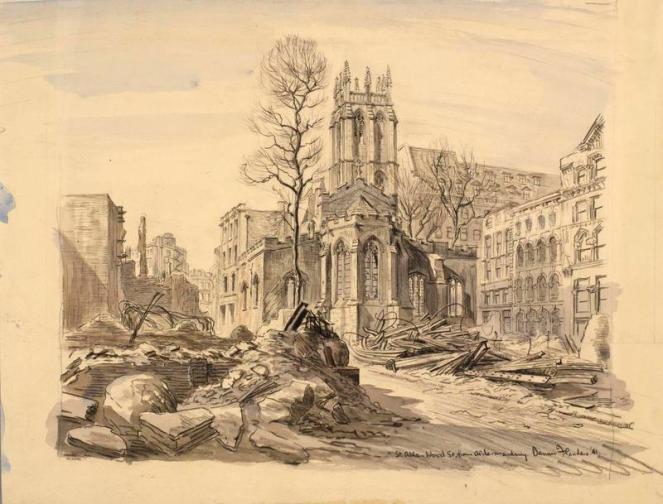
Air raids by the Luftwaffe caused huge amounts of damage to the City of London during the Second World War. The image above shows St Alban’s looking more or less undamaged amid a scene of destruction, but the church was not so lucky in a later raid.
On 29th December 1940, a night where so much destruction was wrought that it became known as “the Second Great Fire of London”, St Alban’s was hit by a bomb and the nave and apse were gutted. Eighteen other churches were destroyed that night, as well as a large number of livery halls. The firestorm caused by the bombings also nearly claimed St Paul’s Cathedral, but the iconic building was saved by the brave actions of firefighters.

After the war, St Alban, Wood Street was one of the churches that was not rebuilt. Demolition of the damaged nave took place in 1955, but the tower – which had survived with remarkably little damage sustained – was kept standing. Today it is marooned on a little traffic island in the middle of the section of Wood Street that runs between Gresham Street and London Wall, an incongruous spot of history amid the tall, forgettable modern buildings that have sprung up around it since the war.
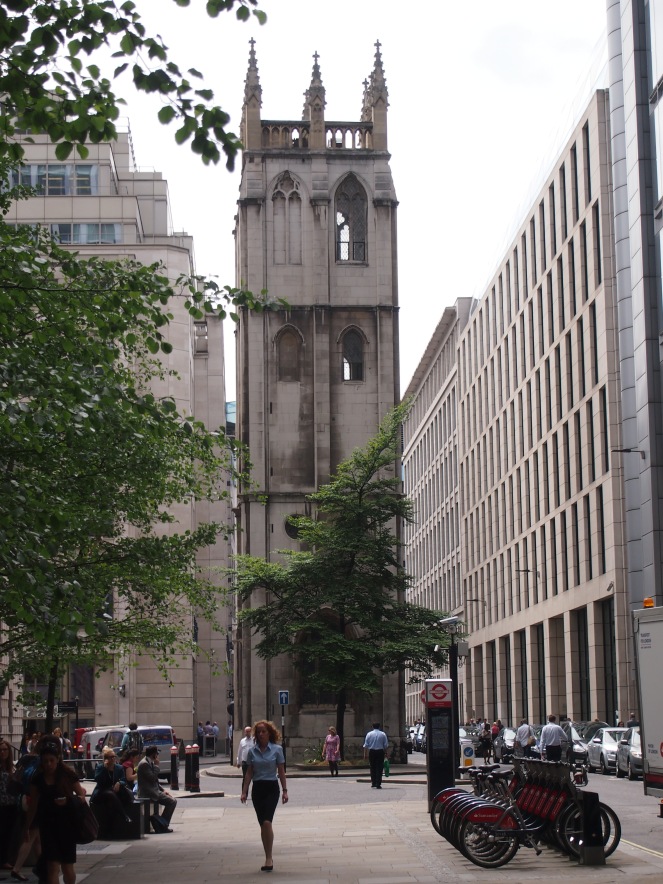
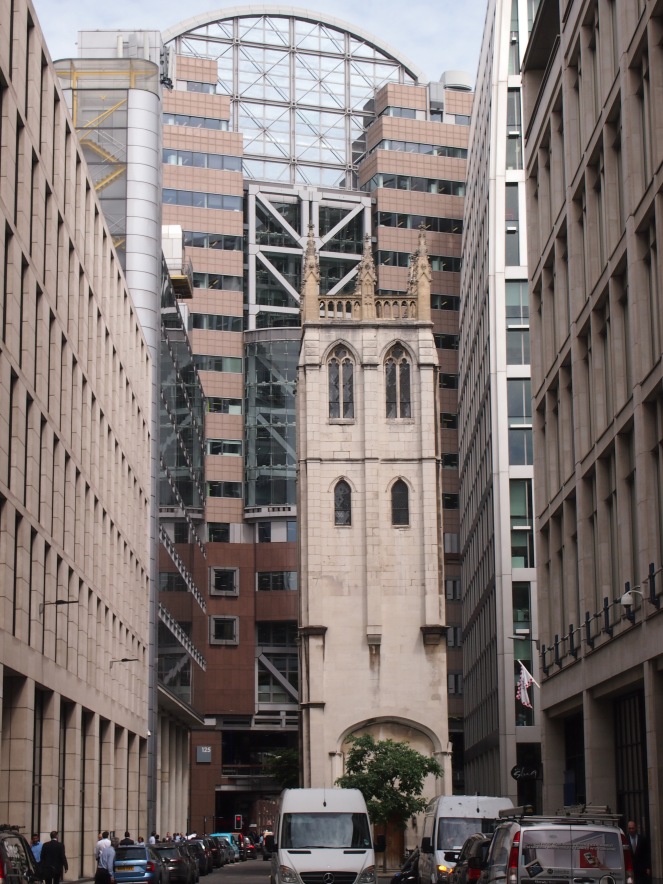
The tower is now a Grade II* listed building, and was converted into a private residence – although these days it is used as office and storage space.
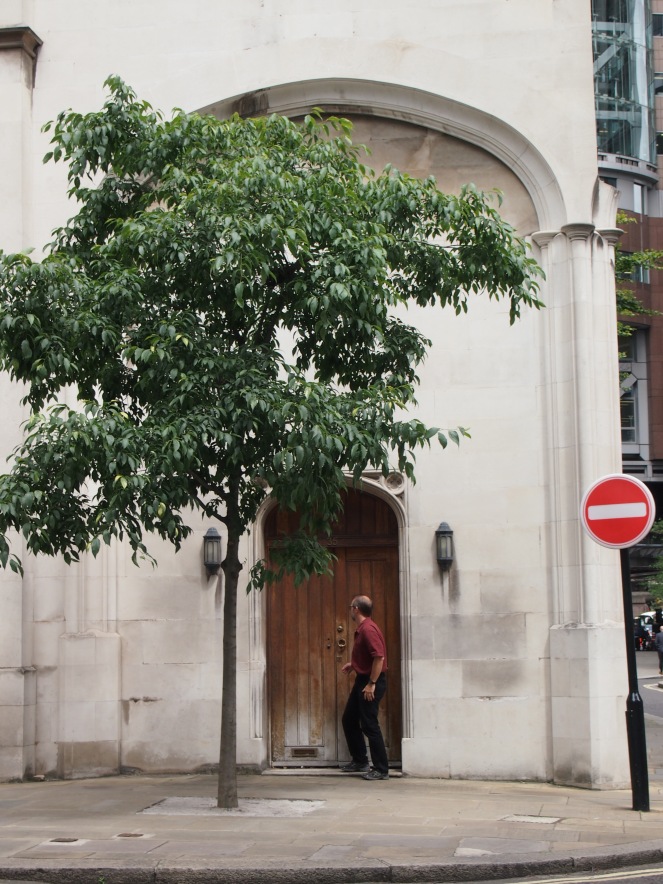
My copy of The London Burial Grounds clearly had a lucky escape. Sadly, the little Ex Libris note at the front of the book doesn’t tell us when the book was deemed surplus to requirements at the library at St Alban’s, so it’s not possible to determine quite how narrowly the book escaped the fires of the Blitz. Having this wonderful old book in my possession makes me feel as though I have a little bit of the history of St Alban, Wood Street on my shelf at home.
References and further reading
London Graveyards and the Wonderful Mrs Basil Holmes, A Parcel of Ribbons, 4th August 2012 http://aparcelofribbons.co.uk/tag/mrs-basil-holmes/
John Stow – Cripplegate warde, in A Survey of London, 1603 (source)
John Strype – A Survey of the Cities of London and Westminster, 1720 (source)
John Strype – Ecclesiastical memorials; relating cheifly to religion, and the reformation, 1721 (source)
Walter Thornbury – Cheapside: Northern tributaries; Wood Street, in Old and New London: Volume 1, 1878 (source)
St Alban’s, Wood Street, and its former sculptural interest http://www.speel.me.uk/chlondon/stalbanswoodst.htm
St Alban’s Tower – London Gardens Online http://www.londongardensonline.org.uk/gardens-online-record.asp?ID=COL054
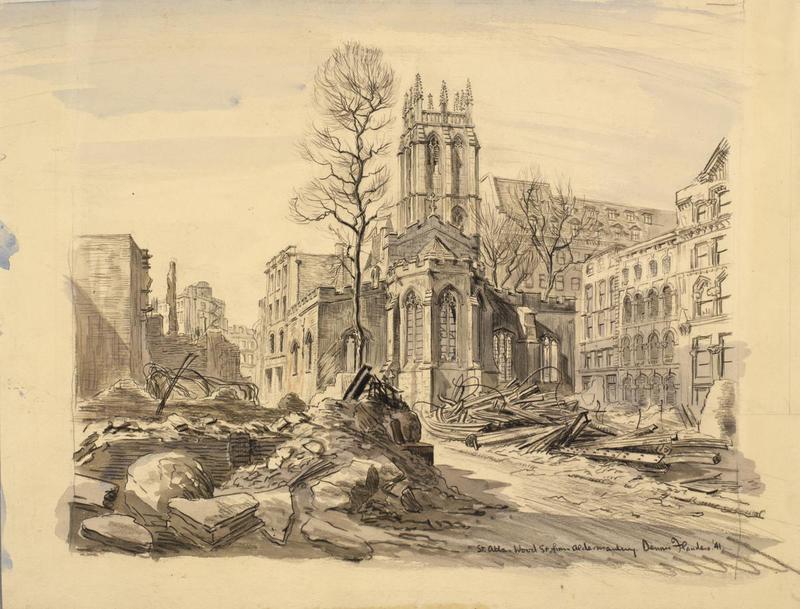

A fascinating article and the book is a wonderful find, coming from the library of St Alban is a real connection and it would be interesting to know when and how the book left the library. As you state the whole area was really devastated by bombing.
I believe the tower is now used by the offices of a corporate finance company rather than a private residence. Would be really interesting to see inside.
LikeLike
It was a lovely surprise to find that the book has links with St Alban – I’ve always loved how old books have “stories” of their own and it’s been great to get a glimpse into the history of this particular copy.
I’d love to see inside the tower, though it sounds as though it may just be used for storage these days.
LikeLike
Makes you wonder. Perhaps someone borrowed the book, but after the air raid perhaps there was no library to return it to? … Interesting how sometimes it’s the fragile things – such as books, rather than stone buildings – which somehow manage to survive.
LikeLike
You’re right, it’s amazing the things that survive over the years!
LikeLike
Very interesting piece Caroline and I love the pictures of the church at different eras that you have found. The final picture is quite symbolic, I think, the church tower completely dwarfed by financial towers. I wonder if the book came from the personal library of Peter Stickley, parish clerk, rather than a church library as such. I’m intrigued by the design of the bookplate which seems to show a child pulling a cross out of its own head and, if my school Latin is right, the motto means’ the cross of Christ is my light’. Thanks for this story.
LikeLike
I’ve always liked the contrast between the church tower and the huge glass towers that surround it. The City is a great place for those contrasts between ancient and modern.
I’ve been trying to find out who Peter Stickley was (other than being the parish clerk at St Alban) but have had no luck so far!
LikeLike
The tower was used in the late 1980s as the marketing suite for 125 London Wall (also known as Alban Gate) Sir Terry Farrell’s love it or loathe it post-modern extravaganza, which is immediately to the north. If I remember correctly, the 1st floor was the kitchen, the 2nd floor held an audio-visual presentation, the 3rd was a dining room and the top floor was the room where deals were to be signed. There was access to the roof to view the construction site.
Unfortunately my photos of the interior and from the roof were lost some years ago.
LikeLike
The church tower must have made for a very unusual marketing suite! Seems appropriate enough, though, if it was overlooking the site that was being developed.
LikeLike
Great post. And one of my favourite books where she comes over as an investigator worthy of sharing Sherlock’s surname. But I suspect that the book was in the Parish Clerk’s private library rather than in the parish library. The Parish Clerk of St Albans probably still exists. Most City of London churches still elect Paris Clerks for churches that no longer exist in their own right but which are looked after by an existing parish church. In the case of St Albans it is St Vedast Foster Lane which shows a Church Warden for St Albans who is I think is likely to be the current Parish Clerk. Dave
LikeLike
I’ve been trying to find out who Peter Stickley was, but so far I’ve not even been able to discover when he was the parish clerk for St Albans! I’m sure there must be some mention of him in an archive somewhere, but all the same it’s nice to know the name of someone who owned the book in the past.
LikeLike
Thank you for the wonderful post.
LikeLike
You’re welcome!
LikeLike
Lucky you! I downloaded this book two years ago because I could not find an affordable copy, or even an available one. I became slightly obsessed with Mrs Holmes and tried to find what happened to her, and where she was buried. I contacted several bloggers, but no one knows her burial place. I suspect she was cremated, because that is what she wanted. I did find out she lived until the 1940s and died in Winchelsea. I am so happy to see this post and read your site often. LUCKY YOU!
LikeLike